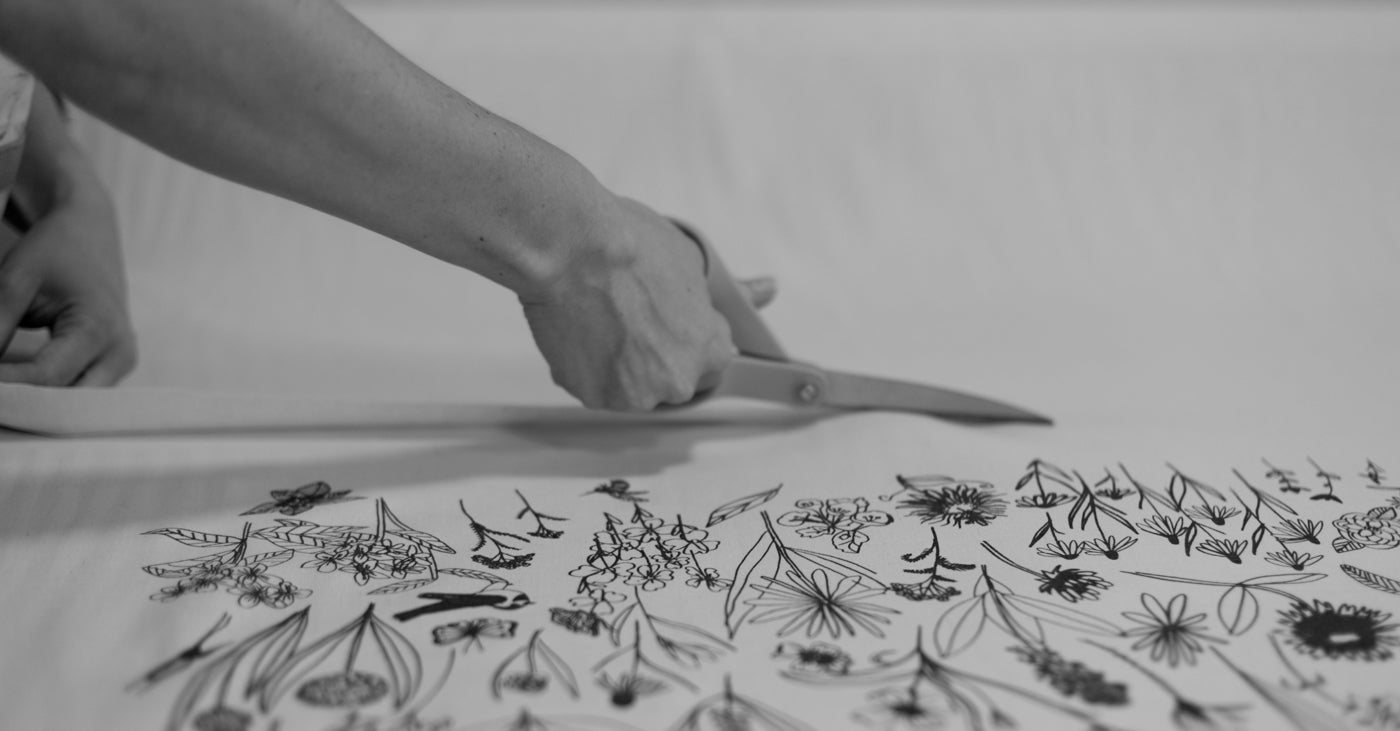
Last year our business model at Sara Parker Textiles began to change. It was clear to me that separating the business into two parts made sense. One side that prints high-quality, ethically-sourced fabrics and another that makes hand-sewn items from that fabric. The majority of items at Maisilene are made with reusable remnant pieces from our print runs at Sara Parker Textiles.
My mission is to close the loop on the amount of textile waste we're creating.
In the beginning of SPT, we weren't sure what to do with our leftover fabric, so we just saved it. It ended up in huge Tupperwares, and bags and boxes in my parents' basement where our print studio started. Most of this fabric came from print tests, sampling, and the rigor of the making process. The idea of not using this material we worked so hard to source was heartbreaking. Organic cotton and hemp fabrics aren't inexpensive!
I felt good about the choices I was making to purchase fabric, but I wasn't sure what to do about the waste we were creating.
Most of this fabric has been used up in various projects at this point, but as we're continually printing new fabrics and coming up with new ideas for Maisilene products, we still make our fair share of textile waste. Here's a rundown of the systems we have in place to help us stay accountable and transparent.
Sorting + Reusing
It makes it easier to think about what you're saving, why you're saving it, and what you're going to do with it when you have some designated areas to keep overflow material.
In the studio we have designated bins for our most popular hand-crafted items at Maisilene. When we have a remnant, we store it in a bin for the item it's best suited for. When we're ready to launch a new collection of that item, or need to fill out the shop, we have those remnants ready to go. In this way, we're not constantly printing new fabrics, but using up what we have on hand.
Fabrics that don't make the cut to be made into new items go into the bin for Fabric Bundles at SPT.

End-of-roll fabric, misprints, and offcuts get made into simple reusable bags for shipping and for customer purchases at both SPT and Maisilene.

Strips of fabric go into a bin for wrapping packages or tying rolls of yardage in the studio.

Small cuts of unprinted cloth are used for ink tests and sampling at SPT.

One of our bins is designated for quilt-making. So far we've made two quilts using our leftovers.



above: building a new garden bed using permaculture techniques in 2015
below: the same garden in 2019

What do you buy frequently that could be reused, either by you or someone else? Do you need to set up a sorting station so you know instinctively where to put that item until you're ready for it? Sorting and designating keeps our studio functional, tidy, and productive.
Recycling
Starting right now, we're designating a bin to recycle our textiles that don't make it past the sorting, reusing, and yard management phase in our studio.
In an ideal scenario, our unusable fabric scraps and thread snips would be broken down and turned back into new fabric. Creating a circular process that creates little to no waste. But, until we come up with a way to manufacture fabric, we're turning to recycling.
I've been doing tons of research online, but it can get overwhelming! If you've been following the blog, you know that Lizzie is a big reader. Her latest find just happened to overlap with our business concerns, and she's happy to recommend The Conscious Closet by Elizabeth L. Cline (and so am I).
Did you know that by volume, fabric and clothing are the fastest growing category of waste in US landfills?
This isn't a problem just because our landfills are overflowing. Natural fibers decompose very slowly, causing high greenhouse emissions. Synthetic fibers never completely biodegrade and leach hazardous chemicals into the air and earth as they slowly break down.
According to the EPA, for every 2 million tons of textiles we keep in circulation and out of landfills, we can reduce carbon emissions equivalent to taking 1 million cars off the road. In fact, reusing one ton of textiles saves twice as much carbon as recycling one ton of plastic.
Fabric scraps can be processed back into fibers and turned into paper, yarn, insulation, carpet padding, and even clothing.
From what I've read, it seems like most clothing donation centers are set up to pass along used clothing to textile recycling centers. I recommend calling your donation center or municipality recycling center to see if they take unwearable clothing and fabric scraps for recycling. For example, here in Athens we have CHaRM and USAgain, where we can take our hard to recycle items.
It can be overwhelming to think of the impact we're having on the environment. And even though I consider our two businesses small potatoes, I like to think our choices are making a small difference. Instead of feeling hopeless and small, it's important to do what we can, wherever we are in life, to make better choices and practice a sustainable mindset.

Resources and insightful links:
https://www.elizabethclinebooks.com/the-conscious-closet
https://www.smartasn.org/SMARTASN/assets/File/resources/Textile_Recycling_Fact_Sheet.pdf
https://www.newsweek.com/2016/09/09/old-clothes-fashion-waste-crisis-494824.html
https://scienceline.org/2018/06/the-troubled-second-life-of-donated-clothes/
https://fashionista.com/2016/01/clothing-donation
https://www.smartasn.org/where-to-recycle/
Comments (0)
Back to SP Blog